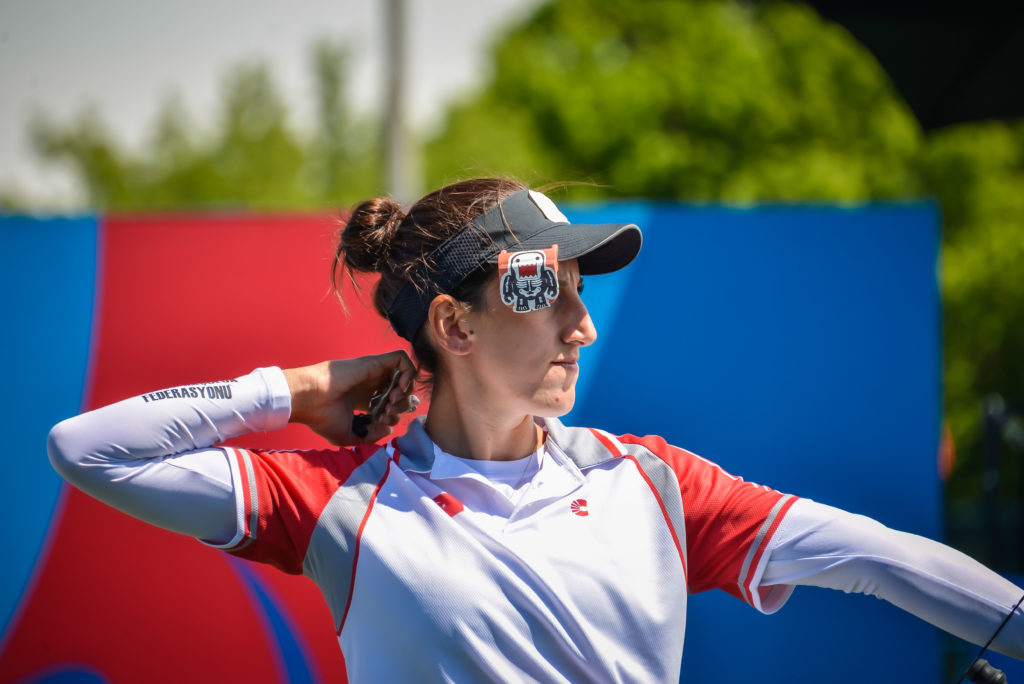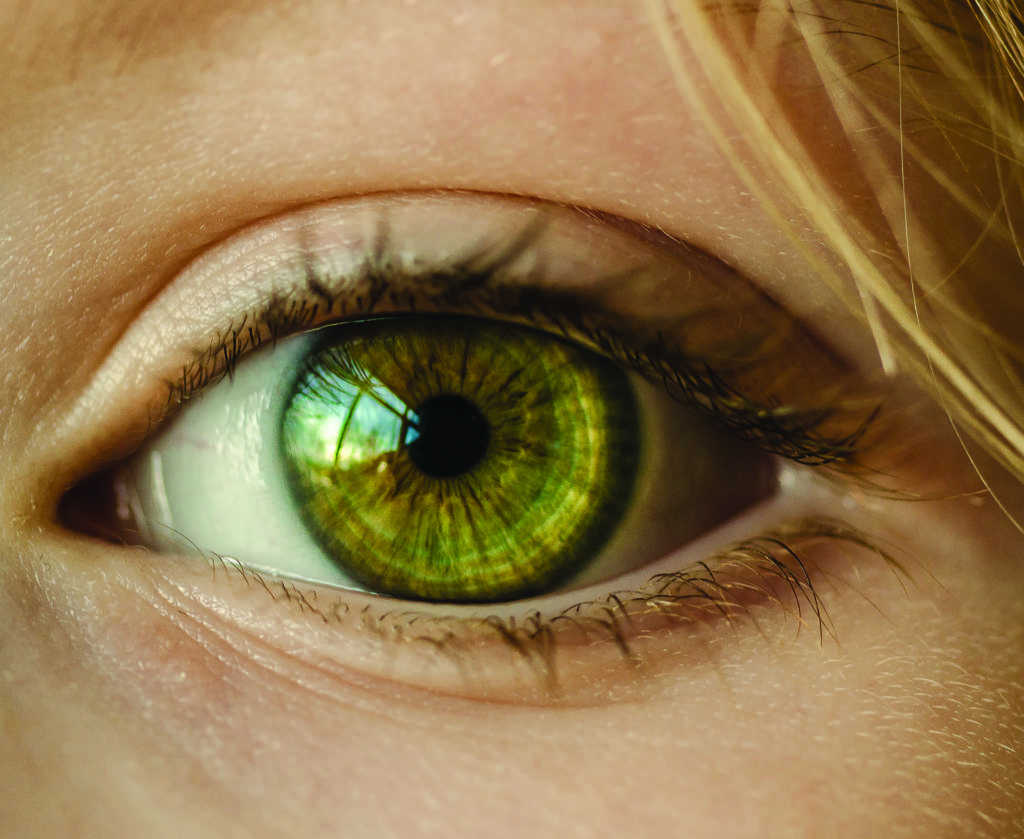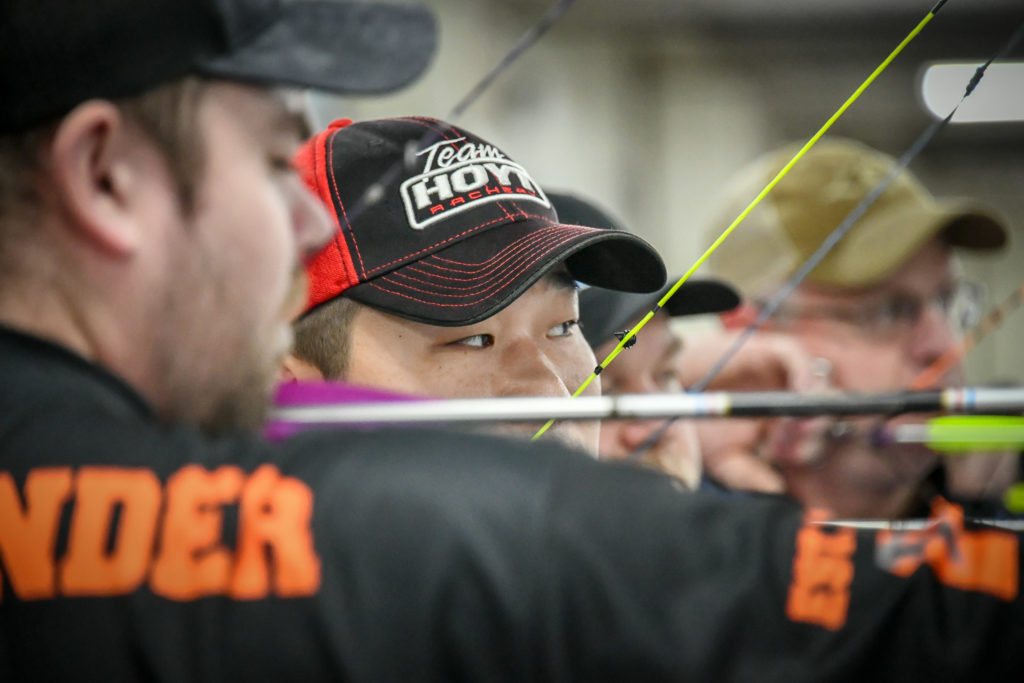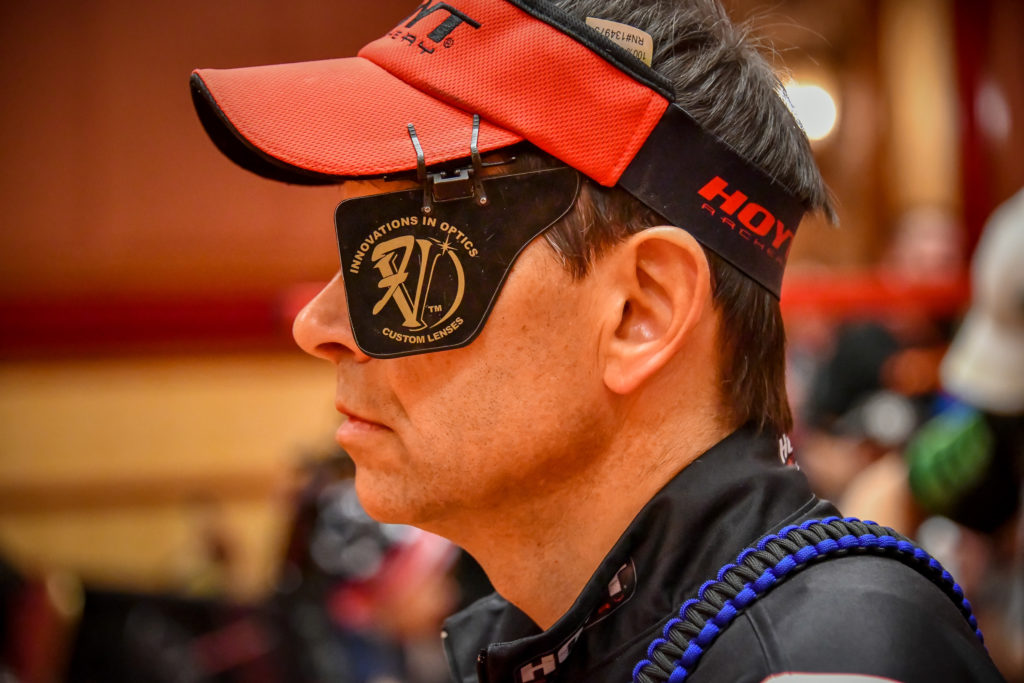Having a dominant eye can be a problem, but Ethan Lowry explores how it doesn’t have to be.

Eye Conditions
As you visualise your target, before you even pick up a bow, the calculations have already been starting in your head. Under pressure, your brain is working overtime to figure out the distance of the target, the trajectory of the arrow, gradient of the land, surrounding terrain and nearby structures.
You may think it obvious that our eyes are involved in this process, but most people forget how delicate an organ they are, and, how easily we can take them for granted. We need to ensure our eyes are kept in the best possible health and treat them appropriately to ensure optimum vision on the day.
Vision conditions
The need to wear glasses or contact lenses are often the most obvious ways in which our eyes can be affected. The most common reason for wearing these is because we have developed one of two vision conditions: myopia (near-sighted) or hyperopia (far-sighted).
As someone who is slightly near-sighted I can occasionally find it difficult to make out detailed objects in the distance (reading street signs while driving).
Others, who may be far-sighted will struggle to see objects closer to themselves (reading a book) The shape of our eyes will often determine which of the two we develop; being far-sighted usually occurs as the eye shortens, whereas near- sightedness develops when the person eye elongates.
Astigmatism is a third condition which affects the shape of the eye (specifically the cornea) and can result in blurred images in objects that are both near and far away.
These conditions are extremely common and nothing to worry about once treated. With both indoor and outdoor archery, you are much more likely to be affected by near-sightedness (difficulty defining objects far away) or astigmatism. A quick appointment to the optometrist will allow for a simple diagnosis and treatment; usually in the form of glasses or contact lenses.
Eye dominance
As we all know, we have a dominant right or left hand; a right or left foot; but likewise we also have a right or left eye. This can also be paired with the vision conditions mentioned above. Eye dominance, like most other vision conditions, can vary in severity.
You may have a slight eye dominance that doesn’t actually affect your archery. You can however have the exact opposite which may significantly affect your accuracy. Most people catch on to this fairly quickly, especially if they have been introduced to the sport by a credible coach.

You can easily determine your eye-dominance through a number of tests, both at home and at the range. An efficient coach will often be able to ascertain this for you, indeed, it is often one of the first things tested on a beginners’ course, although it is well worth having another go and encouraging your club mates too. The most common test is the ‘Miles’ test – the archer extends both arms and brings their hands together to create a small opening between their hands (usually a small triangle). Then, with both eyes open, they focus on a distant object through the opening. They then slowly draw their hands back to their face and whichever eye the hand comes back to their dominant eye.
Another simple test you can perform would be to stand as if you were about to take your shot and with both eyes open, point at your target with as much accuracy as you can. Then, if you you shoot right handed, close your left eye, whilst keeping your finger pointing at the target. If you are no longer pointing at the target, it implies that your left eye may be dominant. This may require multiple attempts and it may benefit to perform this test with a closer object.
Some archers will have a master eye that is opposite to that of their master hand – right-handed with a left master eye or vice-versa. The master eye is the eye that the brain takes information from first. That information is then cross-referenced with information from the other eye and the brain builds a visual picture for us, allowing us to judge speed, distance and trajectory accurately. When we shut one eye, there is no input to cross reference; we have a one dimensional picture and cannot judge those three aspects as accurately.
Having a dominant eye doesn’t have to be a problem, but it can be. The best case scenario is if a right-handed archer has a dominant right eye, or a left-handed shooter with a dominant left eye. In these scenarios it allows the shooter to aim and loose their arrow with both eyes open.
When we shut one of our eyes we are limiting the amount of information our brain receives; instead of two “eyes- worth” of information, we only have one. This both slows and skews the calculations are brain makes when we are aiming at a target.
Keeping both eyes open allows for better hand-eye coordination and better depth perception. The latter of these two is extremely important in archery. Outdoor competitions, especially those involved in field archery, rely significantly on depth and gradient perception when accounting for sloping hills and vegetation that may be the in the way of our target.
Difficulties arise however, when you have a left-dominant eye but shoot right-handed or vice-versa, referred to as cross-dominance. When cross-dominance isn’t corrected for, it will lead to a number of inaccuracies: these can be minute but of course, when it comes to competitive archery, it can be millimetres that makes the difference between first and second place.
Depending on the severity of your cross-dominance there are a number of steps that you can take. The following examples we refer to someone who is a right-handed shooter but has a dominant left eye.

The first and most obvious thing to do would be to close your left eye, but, this means that you would be aiming with your non-dominant eye. Initially, this may affect your accuracy, but most people quickly adapt to this. Having to physically close our eye requires a strange amount of effort.
This can be distracting, especially in the face of competition. One method seen across most shooting sports, is wearing an eye patch or “blinders” as they are commonly known.
This allows the non-dominant eye to remain “open” and therefore relaxed, but prevents it from seeing anything and therefore prevents it from leading to unnecessary inaccuracy with the shot.
Patching things up
There are many options available to archers to overcome the cross dominance, such as a “pirate” eye patch, a patch that clips onto a hat, a patch that clips onto glasses, a piece of cardboard clipped onto the hat, tape over glasses and stickers over glasses. You will see all of these on elite shooting lines.
A great reason for why many archers may opt for an eye patch or cover, as opposed to closing the eye, is that you can train yourself to have both eyes open, thus having the same benefits of letting more light in but being able to focus with the weaker eye.
There are also companies such as Off-Eye which supply filters for different kinds of glasses to use the ability of the brain to filter the target; using different stickers you can decide which strength of filter you need to use to block out enough of the target, by shifting a little or a lot of strength to the weaker aiming eye. (The dominant eye is blinkered and is similar to looking through “venetian blinds” – the image is there but not 100 per cent.)
How can we take care of our eyes?
Like the rest of our body, we can take steps to ensure that we keep our vision in optimum condition. There is no substitute to a healthy lifestyle and this extends to vision. Sleep is one of the easiest ways in which we can take care of our vision.
Lack of sleep can lead to dry eyes and eye spasms both of which can be very distracting when it comes to archery. In the long term, a lack of sleep can lead to damage to blood vessels in the eye, which brings its own ramifications when it comes to vision.

Keeping our eyes moist is an essential part of having clear vision. Our eyes need to be lubricated with tears (made up of oil, mucus and water). Being dehydrated can therefore lead to deterioration in our eyesight.
We’ve covered why we should hydrated in previous articles: optimum vision is simply another reason. Finally, the importance of our diet should never be overlooked. The American Optometric Association recommend a diet rich in antioxidants, and including:
- Vitamin C – Can slow the progression of age-related eyesight loss
- Vitamin E – Prevents oxidative damage to the eyes
- Essential fatty acids – Improve retinal function
- Zinc – Produces melanin, which is a protective pigment found in the eyes.
Seeking a professional opinion
Most vision conditions can be controlled or treated using fairly simple measures. The safest and most accurate way in which we can stay on top of our vision, is to seek the opinion of an optometrist.
More importantly, since vision can and usually does deteriorate as we get older, keeping these check-ups fairly regular is of the utmost importance. Our eyesight, must be taken care of the same as the rest of our health. We must do our best to not take it for granted.


When using my hands to make a circle to help determine the dominant eye, all I see is hand or just part of the target…almost like my eyes are crossed. Any suggestions? My natural tendency is to use my left eye but I am right handed and my accuracy seems better when I force use of my right eye